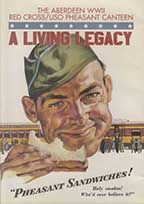September 2020-The Fantastic Pheasant Canteen

Wall Drug has ice water; Aberdeen had pheasant sandwiches.
The Red Cross/United Service Organization’s canteen at the Milwaukee Road depot in Aberdeen became known as “the world’s standout for a handout” for offering a free lunch and showing hospitality to more than half a million servicemen and women during the two and a half years the canteen operated.
“During its existence the canteen became famous the world over for its pheasant sandwiches. In 1945 the canteen cooked more than 9,000 ringnecks,” stated a Monday, March 25, 1946, article in the Aberdeen American-News.
What became known as the Pheasant Canteen opened on Aug. 19, 1943, in the Milwaukee Road depot to troops traveling though the Hub City on trains. Because the Milwaukee Road (the Chicago, Milwaukee, St. Paul and Pacific Railroad) ran from Chicago to Seattle and back, this line was used to help move troops across the United States during World War II.
“The Pheasant Canteen benefited Aberdeen by giving a sense of pride and community spirit as the troop trains would roll in. The community of Aberdeen would band together to serve the troops,” said Casey Weismantel, executive director of the Aberdeen Area Convention and Visitors Bureau.
Offering food and hospitality was something Aberdeen and area residents could do to support war efforts, he said.
Initially, ground ham sandwiches were served, along with cake, cookies, doughnuts, fresh fruit, pie, milk and coffee. Birthday cakes were given to every soldier having a birthday that day.
In December 1943, farmers brought pheasants to the canteen workers and the pheasant salad sandwich became a significant part of the menu. The sandwich consisted of finely chopped cooked pheasant, chopped hard-cooked eggs, grated carrots, chopped onion, sweet pickle relish, salt, pepper and mayonnaise or salad dressing mixed together, chilled and spread on sandwich bread.
Pheasant hunts were organized to keep the canteen supplied with South Dakota’s state bird. Pheasants were plentiful in the state, as the South Dakota Game, Fish and Parks Department estimated a pre-hunting season population of 11 million pheasants in 1943, 15 million in 1944 and 16 million in 1945.
The birds were taken to local locker plants where they were cleaned, processed and stored for future use.
The canteen was operated by volunteers, with Mrs. Max Stokes as chairwoman of the canteen corps. Women were trained as supervisors for the canteen workers. People in Aberdeen and the area pooled their efforts and resources to keep the canteen operating during a time when food, gasoline, tires and other items were rationed.
“Women from towns throughout the Aberdeen trade territory served on special ‘out-of-town’ canteen days, and individuals throughout northern South Dakota, southern North Dakota and western Minnesota contributed money, pheasants and other food-stuffs,” according to the March 25, 1946, Aberdeen American-News. “Monday afternoon the canteen had served 580,902 servicemen and women since its doors were first opened.”
“The Pheasant Canteen became so popular because of the efforts of the volunteers that served the pheasant sandwiches to the troops,” Weismantel said. “In South Dakota, and especially Aberdeen, hospitality goes a long way!”
A photograph in the Sunday, March 31, 1946, Aberdeen American-News shows two servicemen at the Milwaukee Road depot raising glasses in a farewell toast. Volunteers met their last train on March 30, and the canteen ceased operating. The 16 Hub City women who were on duty on Aug. 19, 1943, when the canteen served its first servicemen, were there to serve sandwiches, as well as three other women who had perfect attendance on the days assigned them to assist.
The pheasant sandwiches and Pheasant Canteen did not fade into history.
In the 2000s, a team of Red Cross members and volunteers started creating the Pheasant Canteen display in the same building where the troops were served. The team received two awards for its work from the American Association for State and Local History in 2012.
Articles in the Aberdeen American-News at various times reported that programs about the history of the Pheasant Canteen were presented at club meetings, and that pheasant sandwiches were served at events, meetings and to Honor Flight veterans. Honor Flights transport military veterans to Washington. D.C., to see the memorials of the wars in which they fought at no cost to the veterans.
When Weismantel joined the Aberdeen Area Convention and Visitors Bureau 15 years ago, the CVB started welcoming pheasant hunters flying into the Aberdeen Regional Airport by offering them pheasant sandwiches. The CVB office is housed in the former Milwaukee Road depot, with the Pheasant Canteen display located nearby.
Weismantel last year offered a pheasant salad sandwich to a veteran who had flown into the Aberdeen Regional Airport, saying it was the same recipe used during World War II. The man said he hadn’t had a pheasant sandwich since he passed through Aberdeen on a troop train. Tasting the sandwich, the veteran said it brought back a lot of memories.
This year, hunters arriving at the Aberdeen Regional Airport will not be offered pheasant salad sandwiches because of the coronavirus. They will still receive a taste of the legendary hospitality shown to travelers with greetings from CVB representatives.
This moment in South Dakota history is provided by the South Dakota Historical Society Foundation, the nonprofit fundraising partner of the South Dakota State Historical Society at the Cultural Heritage Center in Pierre. Find us on the web at www.sdhsf.org. Contact us at info@sdhsf.org to submit a story idea.
